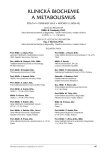-
Medical journals
- Career
Haemolysis influence on the determination of total and direct bilirubin
Authors: J. Procházka 1; K. Bořecká 2; V. Lánská 3
Authors‘ workplace: Oddělení klinické biochemie, Nemocnice s poliklinikou Česká Lípa, a. s., Česká Lípa 1; Oddělení klinické biochemie, Thomayerova nemocnice, Praha 2; Oddělení lékařské statistiky, IKEM, Praha 3
Published in: Klin. Biochem. Metab., 21 (42), 2013, No. 4, p. 215-219
Overview
Objective:
We tested an effect of hemolysis (H index) on concentrations of total and direct bilirubin to determine the thres-hold level of hemolysis, until which quantitative results can be issued only with an additional comment.Materials and Methods:
We added haemolysate to serum samples with low primary concentration of total or direct bilirubin and created different degrees of hemolysis. Then we established a deviation from original values of bilirubin concentration by repeated measurement and statistically processed (by the least squares method and by the contrast method in the analysis of variance).Results:
We found negative bias in the case of both total and direct bilirubin. However a rise of primary bilirubin concentration was expressed in samples with high hemolysis, caused probably by increased absorbance of hemoglobin, then by direct photometric interference. The rise was significant mainly in samples with low original concentration of direct bilirubin. We deduced the threshold level of hemolysis for measurement of total (H index 95) and direct bilirubin (H index 53) by method used in our laboratory.Conclusion:
We have verified the effect of hemolysis on concentrations of total and direct bilirubin by the experiment based on routine laboratory practice. We have determined the threshold level of hemolysis, until which quantitative results cannot be issued.Keywords:
bilirubin, hemolysis, serum indices.
Sources
1. Trenčanská, Š. Ovlivnění biochemických analýz stavem biologického materiálu (hemolýza, ikterita, chylozita), bakalářská práce 2009, dostupné na webu: http://is.muni.cz/th/215065/lf_b/Bakalarska_prace.pdf.
2. Autorský kolektiv. Preanalytická fáze, Česká společnost klinické biochemie ČLS JEPa SEKK s.r.o., 2005, ISBN 80-239-5198-X, str. 11-17.
3. Beňovská, M., Dastych, M., Čermáková, Z., Tůmová, J. Preanalytické interference a praktické využití sérových indexů. Klin. Biochem. Metab., 2010, 18 (39), 3, p. 144-148.
4. Lippi, G., Salvagno, G. L., Montagnana, M., Brocco, G., Guidi, G. C. Influence of hemolysis on routine clinical chemistry testing. Clin. Chem. Lab. Med., 2006, 44, p. 311-316.
5. Lippi, G., Blanckaert, N., Bonini, P., Green, S., Kitchen, S., Palicka, V., Vassault, A., Plebani, M. Hemolysis: an overview of the leasing cause of unsuitable specimen in clinical laboratories. Clin. Chem. Lab. Med., 2008, 46, p. 764-772.
6. Guder, W. G., Narayanan, S., Wisser, H., Zawta, B. Samples: From the Patient to the Laboratory, 3rd edition Weinheim: Wiley – VCH 2003, 102 p. ISBN 3 527 30981-0.
7. Příbalové informace souprav Bilirubin Total DPD Gen. 2 a Total Bilirubin liquid, Bilirubin Direct a Serum Index Gen. 2.
8. Bicanová, A., Grofová, P., Racek, J. Vliv hemolýzy na klinicko-biochemická vyšetření. Biochem. Clin. Bohemoslov., 17, 1988, p. 517-528.
Labels
Clinical biochemistry Nuclear medicine Nutritive therapist
Article was published inClinical Biochemistry and Metabolism

2013 Issue 4-
All articles in this issue
- New generation of hs cardiac troponins and diagnosis of acute coronar syndrome - minireview
- Trace elements in critical states. Part 1: zinc and iron
- Trace elements in critical states. Part 2: copper and selenium
- Hypercholesterolemia in pregnancy - pathobiochemical and pathophysiological implication for atherosclerosis and evaluation in metabolic surgery
- Haemolysis influence on the determination of total and direct bilirubin
- Cerebrospinal fluid analysis in the diagnosis of subarachnoid hemorrhage
- Clinical Biochemistry and Metabolism
- Journal archive
- Current issue
- Online only
- About the journal
Most read in this issue- Haemolysis influence on the determination of total and direct bilirubin
- Cerebrospinal fluid analysis in the diagnosis of subarachnoid hemorrhage
- Trace elements in critical states. Part 1: zinc and iron
- Trace elements in critical states. Part 2: copper and selenium
Login#ADS_BOTTOM_SCRIPTS#Forgotten passwordEnter the email address that you registered with. We will send you instructions on how to set a new password.
- Career

